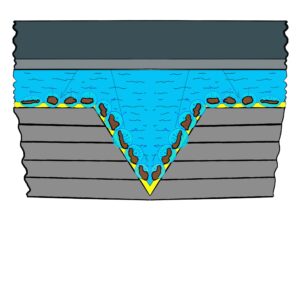CLEANING Method InfoRMATION.
THE OLD FASHION CLEANING METHOD – WORST
The old fashion way to clean your records is to use a velvet covered foam cleaning pad or cloth, which you then place on the record surface while it rotates on your record deck. The drag created by the pad or cloth will then pick up minor dust particles from the upper ridges of the record, but not deep into the groove itself.
This is a superficial method of cleaning your records, especially older and perhaps more valuable items. Anything before the 2000’s at least, that has been played to any degree and exposed to atmospheric dust, or sweaty hands and fingers, will still have a substantial amount of dust, debris and body fluids (sweat) located deep into the record groove. Everyone’s fingers leave sweat deposits no matter how you try to avoid this. (I wear latex gloves when handling and playing my own Premier cleaned vinyl)
Illustration of the record vinyl groove with dust and debris particles, and the suggested effectiveness of using a manual record cleaning pad or cloth.
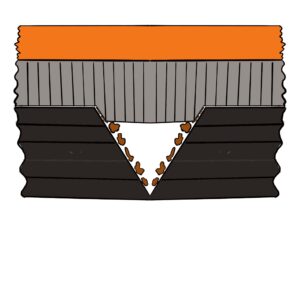
Conclusion – I honestly think this cleaning method does very little if anything, to improve your record’s playing quality or clarity, and is no more effective than removing the top surface of dust naked to the eye. Blowing on it would be just as effective, although not recommended. The record stylus meanwhile sitting in its vinyl groove when it’s played, possibly does a similar and better job to disperse some of that dust and debris, but that won’t help the prolong the condition of your stylus, and your records are still dirty and playing just as slow.
I previously used a Disco-Antistat manual cleaner, and thought at the time this was quite a good, effective and affordable way to clean my own record collection, but not now. I know this basic method is simply not sufficient to remove years and decades, of finger prints, dust and debris, smoke and air bourn material that collects on a record surface, and especially those bought and collected on the second-hand market.
THE STANDARD CLEANING METHOD – Better
The Standard Cleaning process uses the Moth MKII vacuum machine combined with a cleaning solution, which is applied to each side of the vinyl surface in forward and backward directions with a fine brush.
The cleaning solution is then removed by vacuum suction on the underside of the vinyl, again in a forward and backward direction, then turned and repeated. After vacuuming the vinyl records are stacked onto our vinyl spinning machines, ready to be placed into the Ultrasonic baths.
The Ultrasonic bathing causes an effect on the record surface to create and form cavitation bubbles, which then explode and disrupt the dust and debris lodged in the vinyl groove. The records are left spinning in the baths for approximately 15 mins.
Illustration of the record vinyl groove with dust and debris particles, and suggested effectiveness of using the Moth MKII vacuum machine and cleaning fluid.
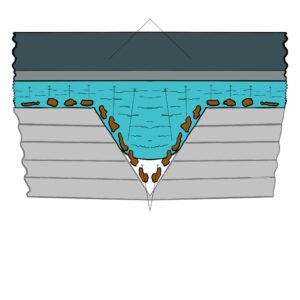
When finished, the records are left to dry for 5-10 mins, before a gentle wipe to remove any remaining water drops. When totally dry, records are given an antistatic treatment and immediately returned to their original inner sleeve (or if specified, a new inner sleeve) and album cover.
Conclusion – I consider this process to be very effective on relatively newer or less played, and therefore less dirty records. I consider this has a cleaning efficacy of 60-70%, and from looking at the track analytics downloaded to a PC (using the Audacity App) pre and post cleaning, a single 3-4 minute track can reduce it’s playing time by over a second, due to less drag and friction on the stylus within the vinyl groove.
This method has certain limitations, as the cleaning fluid won’t completely penetrate to the bottom of the record groove, due to the ever-present surface tension of the liquid itself, and the air trapped under the fluid.
Illustration of the record vinyl groove with dust and debris particles, and suggested effectiveness of using the Ultrasonic bath after the Moth MKII vacuum machine process.
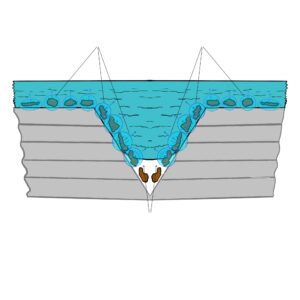
The Premier Cleaning Process increases the cleaning capability by allowing a deeper penetration of cleaning fluid into the record groove.
THE Premier CLEANING METHOD – BEST!
The Premier Cleaning method is a more timeous process than Standard. Each side of the record playing surface is first coated with a mix of distilled water with a precise measure of Surfactant. This is a substance which reduces the surface tension of a liquid in which it is dissolved, which then soaks deep into the record groove. Then this allows for the deepest penetration of our cleaning fluids in the Moth Mk II vacuum and Ultrasonic bathing processes.
Each record playing surface (and not the label) is gently coated with this liquid with a fine brush, and then left to dry on a drying rack, before then repeating the process of the opposite side. Drying can take approx. 1-2 hours for each side dependant on ambient room temperature.
When this is completed, the records are then cleaned and processed in the exact same manner as the Standard cleaning method, using the Moth Mk II vacuum, Ultrasonic bathing and Zerostat 3 antistatic application.
Illustration of the record vinyl groove with dust and debris particles, and suggested effectiveness of using the Surfactant cleaning solution prior to Moth MkII and Ultrasonic bath.
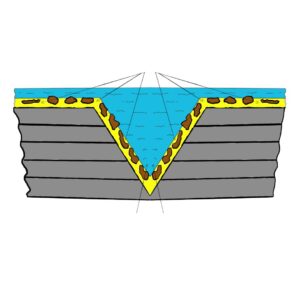
Conclusion – I consider this Premier cleaning to be the very best and most effective process for cleaning your oldest and most played vinyl. Since these are likely to be the most handled (with sweaty finger prints, etc.) and over time more atmospherically exposed, the dirtier these records will be.
I believe that it has a cleaning efficacy of 90% +, and from looking at the track analytics downloaded to a PC (using the Audacity App) pre and post cleaning, a single 3-4 minute track can reduce its playing time by over 2 seconds (approx. 1 second better than the Standard clean), due to even less drag and less friction on the stylus within the vinyl groove.
When doing the same analytics pre and post clean on a full side of an album, evidence shows there is between 6-10+ seconds shorter playing time on a Premier cleaned vinyl album. (Link to screen pictures)
All Illustrations Created by – SWB & TWB on (iPad App – Procreate)
Illustration of the record vinyl groove with Moth MKII vacuum machine process and Ultrasonic bath removing dust and debris particles, and the suggested effect as the Surfactant fluid allows for more effective cleaning.
